|
||
 |
||

@
(C)2001 Japanese Architecture and Art Net Users System.@No reproduction or republication without written permission.
fΪΜeLXgEΚ^ECXgΘΗASΔΜRecΜ³f‘»E]ΪπΦΆά·B
|
||||||
| @ | ||||||
| kyoshimon@Ά | ||||||
| KEY WORD :@architecture / roofing tiles | ||||||
| @ | ||||||
| Also called sen kyoshimon όΆ. Saw-tooth pattern. Kyoshimon includes the zigzag pattern *inazumamon ξΘΆ, a chevron pattern yamagata R`, and wave pattern hamon gΆ. Zigzag patterns found on the pendant tile *gatou ’, of a semi-circular eave end tile *nokimarugawara ¬Ϋ’, and on the top or bottom outer borders of a concave eave end tile *nokihiragawara ¬½’. They were also used to decorate some Yayoi period bell-shaped bronzes doutaku Ίφ. There were two main pattern types used on tiles. One was used to decorate the periphery of a tile@with a raised zigzag line which resembles the teeth of a common saw. It was a linear pattern placed between the outer edge and the bead pattern *shumon μΆ, confined between two concentric circles. In the example unearthed at the ruins of Senkyouji (Funabashidera) D΄, the zigzag pattern reaches from the rim of the tile to the circle enclosing the lotus motif. The other is composed of a series of solid, sharp triangular teeth pointing toward the tile rim. These do not have a linear quality but look like very strong, solid saw teeth nokogiriba . They appear to be unattached to the outer part of the two concentric circles. Their pointed tips do not extend to the edge of the rim. This motif first appeared on tiles in the mid to latter half of the 7c. and is rarely found now. The pattern's popularity waned during the 8c and had virtually disappeared during the Heian period. However, two more examples were unearthed at the Aoki ΒΨ ruined temple site, and are considered to be early 10c. The technique shows high relief and has one tile with an inscription, Daiku Wanibe Sadayuki εHamεs, giving the name of the carpenter. | ||||||
| @ | ||||||
 |
||||||
@ |
||||||
| REFERENCES: | ||||||
| @ | ||||||
| EXTERNAL LINKS: | ||||||
| @@ | ||||||
| NOTES: | ||||||
| @ | ||||||
(C)2001 Japanese Architecture and Art Net Users System.@No reproduction or republication without written permission. fΪΜeLXgEΚ^ECXgΘΗASΔΜRecΜ³f‘»E]ΪπΦΆά·B |
||||||
| @ |